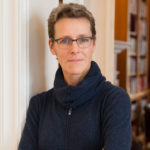 Kate Brown
Kate Brown
Professor of Science, Technology, and Society (STS)
Kate Brown’s research interests illuminate the point where history, science, technology and bio-politics converge to create large-scale disasters and modernist wastelands. She is the author of several award-winning books, including Manual for Survival: A Chernobyl Guide to the Future (2019), Dispatches from Dystopia: Histories of Places Not Yet Forgotten (2015), Plutopia: Nuclear Families in Atomic Cities and the Great Soviet and American Plutonium Disasters (2013), and A Biography of No Place: From Ethnic Borderland to Soviet Heartland (2004).
She is currently exploring the history of what she calls “plant people:” indigenes, peasants and maverick scientists who understood long before others that plants communicate, have sensory capacities, and possess the capacity for memory and intelligence. She teaches environmental history, Cold War history, and creative non-fiction history writing.
More information on Prof. Brown can be found on the STS faculty website.
 Leslie Norford
Leslie Norford
Professor of Building Technology, Department of Architecture
Leslie Norford is the George Macomber (1948) Professor in Construction Management in the Department of Architecture and an MIT MacVicar Faculty Fellow. A member of the MIT faculty since 1988, his interests focus on reducing building energy use and associated resource consumption and carbon emissions and on the interactions of buildings with urban environments and electricity grids. He has worked in Russia, China, Pakistan, the UK and Norway. His ongoing research in Singapore, as a member of the Center for Environmental Sensing and Modeling (CENSAM), an interdisciplinary research group in the Singapore-MIT Alliance for Research and Technology (SMART), includes measurements and models of urban temperatures and airflows, simulations to identify strategies to reduce the urban heat island effect, estimations of the impact of the urban environment on natural ventilation of buildings and building cooling requirements, and opportunities to reduce urban air pollution and temperatures through electrification of urban transportation.
He holds a B.S. in Engineering Science from Cornell University and a Ph.D. in Mechanical and Aerospace Engineering from Princeton University. Prior to his graduate work, Prof. Norford served in the U.S. Navy and Department of Energy as a nuclear power engineer.
Read more about Prof. Norford on the MIT Architecture website.
 John Sterman
John Sterman
Professor of Management at the MIT Sloan School of Management and Director of MIT’s System Dynamics Group
John D. Sterman is the author of many scholarly and popular articles on the challenges and opportunities facing organizations today, including the book Modeling for Organizational Learning, and the award-winning textbook Business Dynamics. Prof. Sterman’s research centers on improving decision making in complex systems, focusing on environmental sustainability, climate change, alternative fuel vehicles and process improvement in organizations. He pioneered the development of “management flight simulators” of corporate and economic systems, many of which, including the C-ROADS interactive climate policy simulation he helped developed, are used around the world by governments, businesses, universities and the public.
Among his honors, Sterman is the recipient of an honorary doctorate, has twice been awarded the Jay W. Forrester Prize for the best published work in system dynamics, received the best application award from the System Dynamics Society, was named one of MIT Sloan’s “Outstanding Faculty” by the BusinessWeek Guide to the Best Business Schools, and has received seven awards for teaching excellence from the students at MIT.
Read more about Prof. Sterman on the Sloan and System Dynamics Group websites.
 Kerri Cahoy
Kerri Cahoy
Professor of Aeronautics and Astronautics, Associate Department Head
Kerri Cahoy is a Professor of Aeronautics and Astronautics, Co-director of the Small Satellite Collaborative, a Bisplinghoff Faculty Fellow, and the Chair of the Diversity, Equity, & Inclusion (DEI) Committee.
Her science interests involve atmospheric sensing and exoplanet detection and characterization, and her technology demonstration interests include laser communications, adaptive optics, and autonomy. Teaching-wise, her interests include Satellite Engineering, Remote Sensing, and Space Systems Design.
Currently, she is working on research in the area of autonomous artificial intelligence-enabled rapid sensor fusion (which combines data from different sensors, such as radar and cameras) onboard satellites to improve understanding of the impacts of climate change, specifically sea-level rise and hurricanes and flooding in coastal regions.
Learn more about Prof. Cahoy and her research on the MIT AeroAstro or MITOS websites.
 Talia Tamarin-Brodsky
Talia Tamarin-Brodsky
Assistant Professor in Climate Science
Talia Tamarin-Brodsky’s research is driven by questions on the interface between weather and climate. She uses novel approaches, by combining Lagrangian and Eulerian perspectives, to answer pressing issues in atmospheric and climate sciences. Her research interests include atmospheric temperature variability and how it responds to climate change, atmospheric dynamics, regional climate and extremes, subseasonal-to-seasonal predictability, and stratosphere-troposphere interactions.
Her work on midlatitude storms tracks includes studying mechanisms that control the formation, propagation, intensity, and spatial distribution of storms tracks. For example, she applies a Lagrangian storm-perspective to explain the poleward deflection of midlatitude storm tracks in the northern hemisphere, and the projected poleward shift of the storm tracks under climate change. Her work suggested that the latter can be understood by the increased tendency of individual storms to propagate poleward, and explained why it occurs.
More information on Tamarin-Brodsky can be found on the MIT EAPS website.
